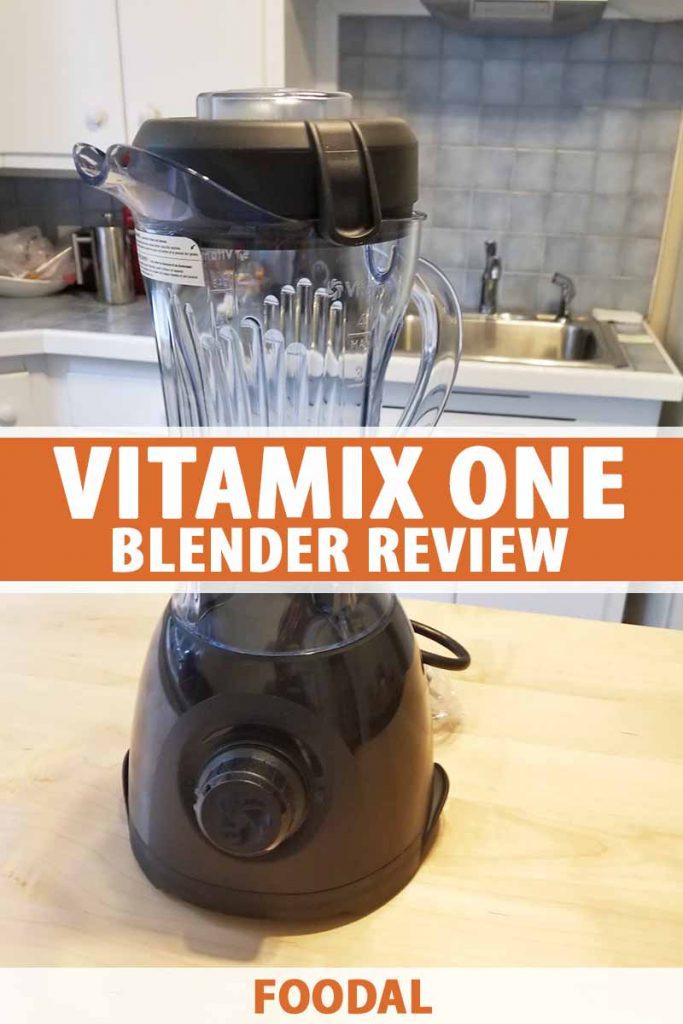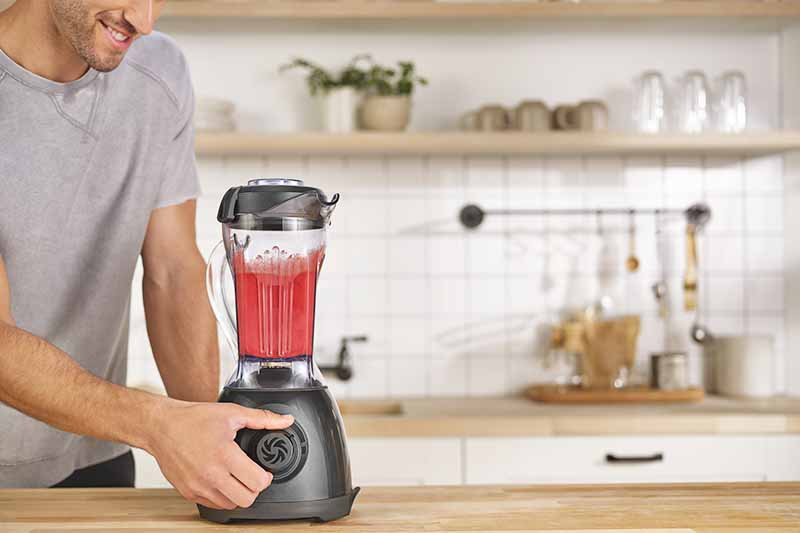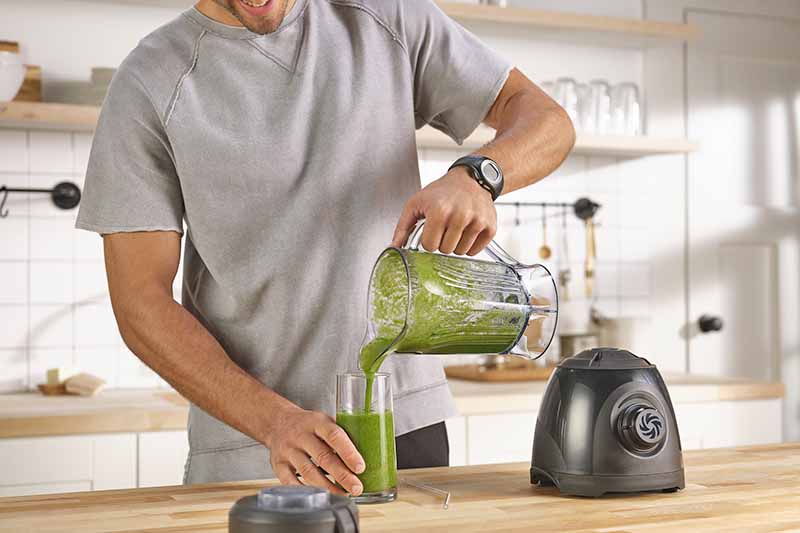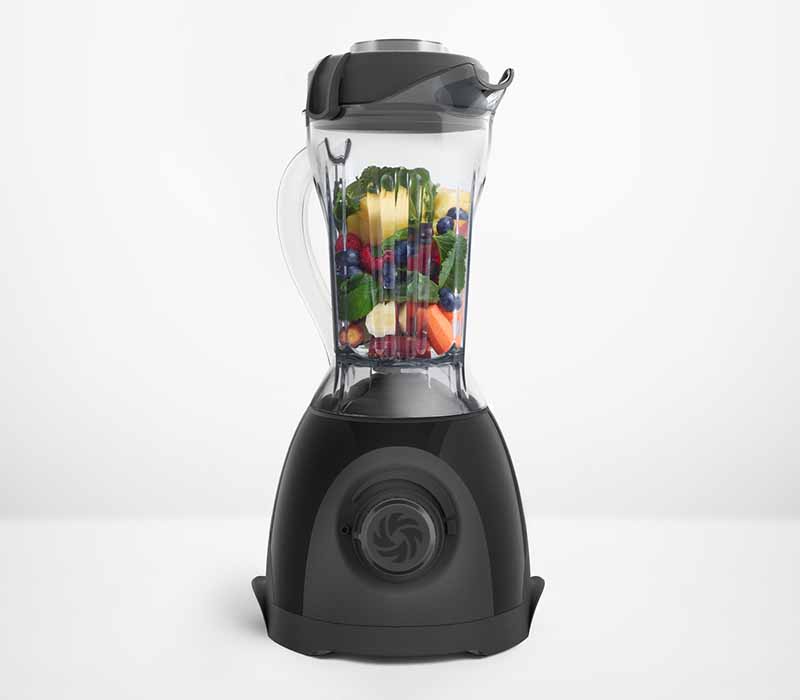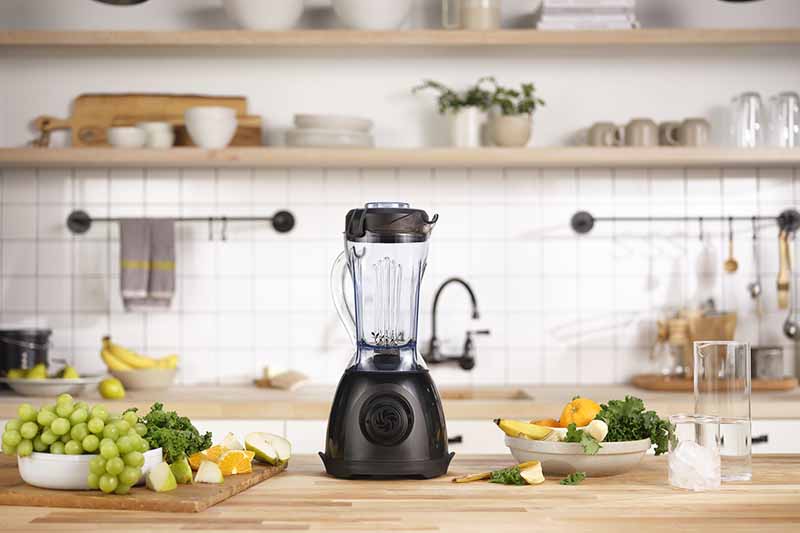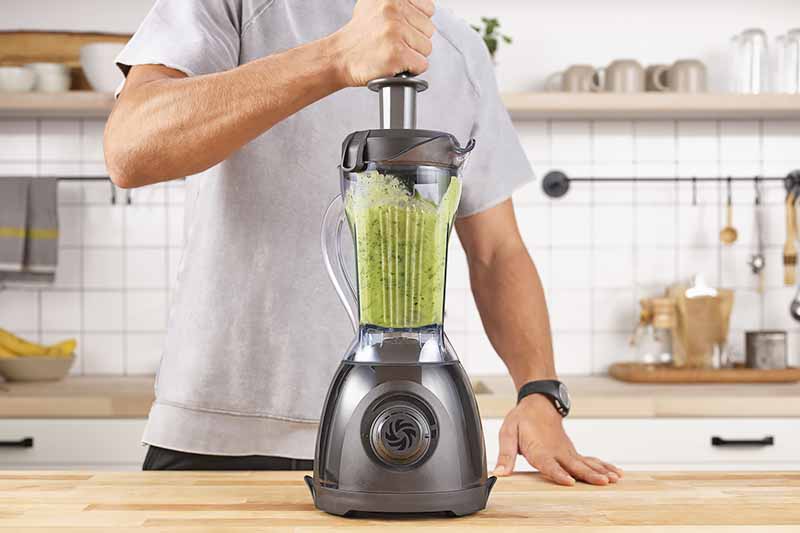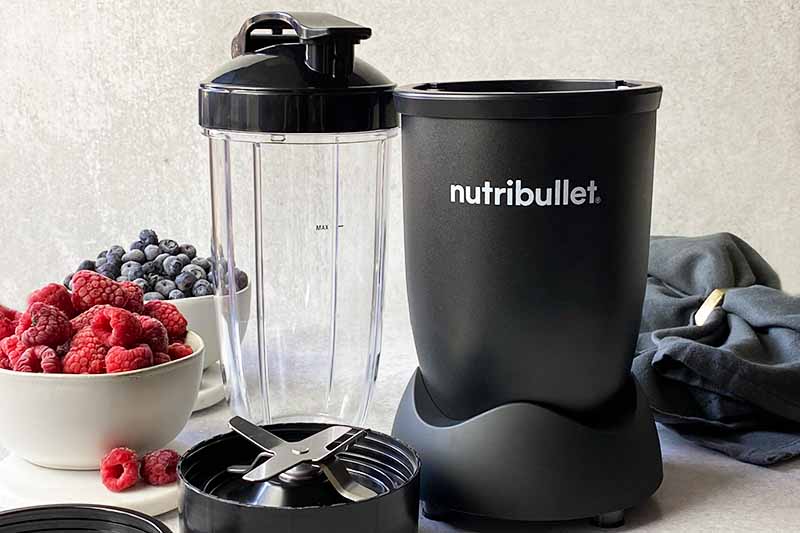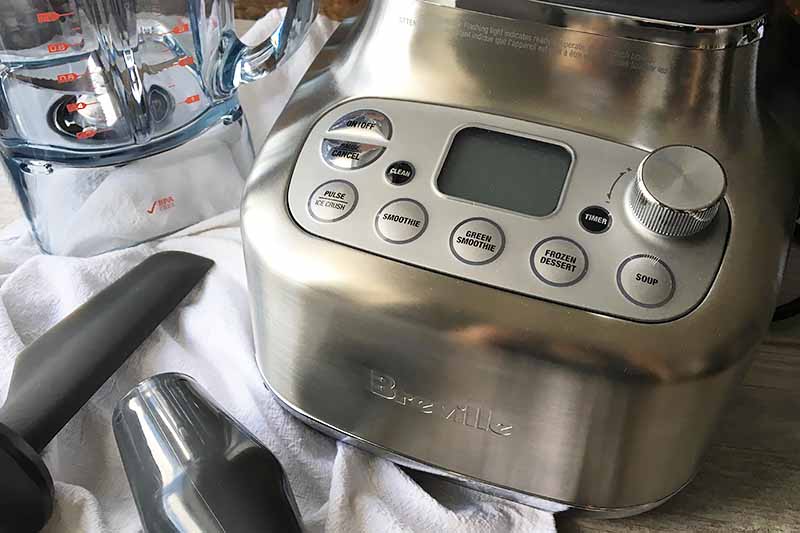If you already have a Vitamix and you’re looking to upgrade, unless you’re downsizing in other areas of your life and what you seek is all about simplicity with a small footprint, first and foremost, this isn’t going to be the model for you.
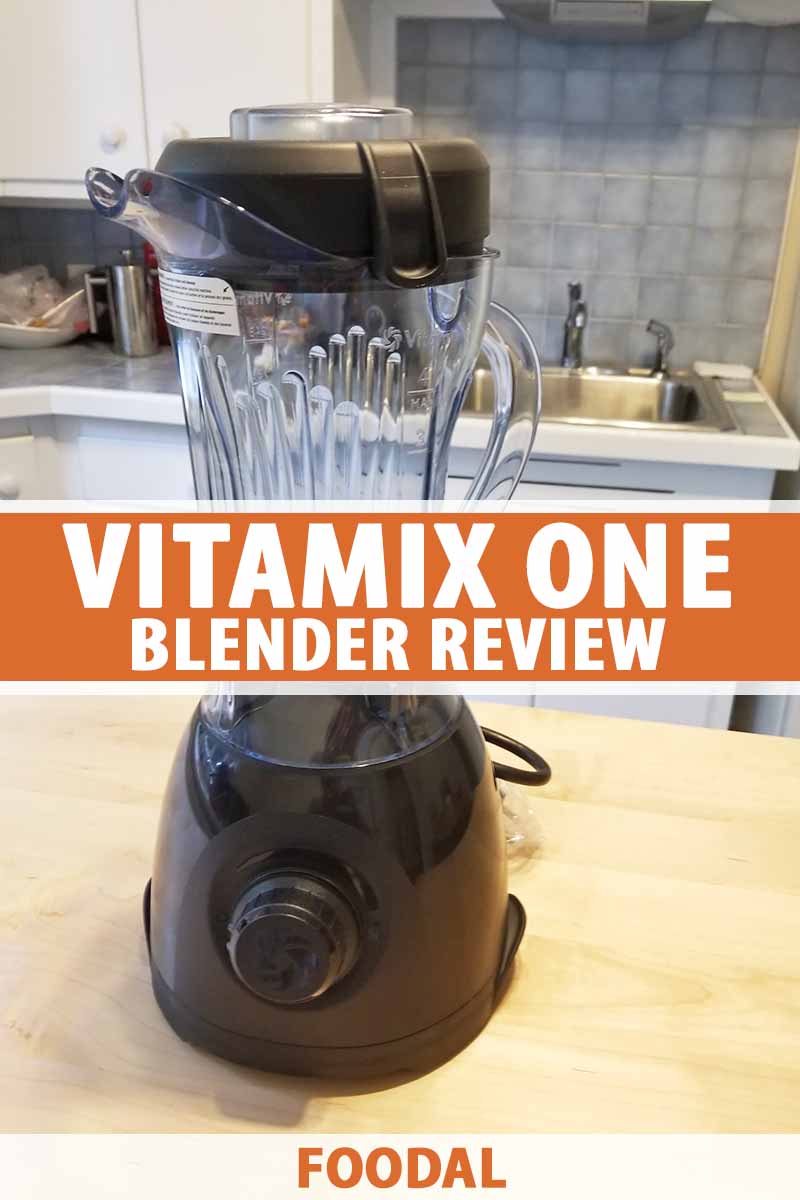
But if you’re looking for a second Vitamix that’s a bit slimmer and more portable, if you want to give one as a gift to welcome a loved one to the Vitamix family, or if you’re eager to join Team Vitamix yourself but you’re not quite able to swing the hefty investment, you just might fall in love with the ONE!
Vitamix ONE, available direct from the manufacturer
Here’s everything we’ll cover in this review of the ONE from Vitamix:
All About the ONE Blender from Vitamix
If you’ve used a Vitamix blender before at home or at work and you’re sold on the brand, this may, for some people, be a truly marvelous entry level option if you’re ready to make a purchase.
Let’s take a look!
Features and Specs
This blender is a Vitamix, but without some of the specific bells and whistles that seasoned users may be accustomed to.
So, what’s in the box?
Your purchase includes the “mighty powerful” motor base with a variable and easy to use speed control knob on the front, a 32-ounce Tritan BPA-free pitcher-style blending container, and a tamper. Based on the size of the box, you can tell that this isn’t a monster that’s going to take up all of your counter or cabinet space.
That “countertop-friendly” size is about 16 inches tall when the pitcher with 2-part lid on top is in place on top of the motor base, and the round base has a diameter of 7 inches.
The ABS motor base weighs under 5 pounds (4 pounds, 9.8 ounces on my kitchen scale). This may sound like a lot, but in comparison to my classic Vitamix 7500 base that weighs over 10 pounds, the ONE is a skinny Minnie, diminutive in size.
The motor has seven amps of power, and operates at 50 to 60 Hertz, meaning the rotor of the generator turns 50 to 60 cycles per second, depending on the operating speed.
The three-prong 120-volt grounded power cord is not what I’d call super short, but it’s not particularly long either. This is not unusual, perhaps a safety measure among certain kitchen appliances with a powerful cutting mechanism.
Adapters and extension cords cannot be used, or this will void the warranty. Count on planning to use this appliance close to an outlet, without a lot of extra reach. It’s suitable for indoor household use only.
The power cord is not removable or retractable, and unlike some other blenders, it does not have a recess or slot in the base for cord storage. It’s about 32 inches long, counting the plug and the base where it’s connected, give or take an inch or so.
It does, however, have two indentations on either side of the bottom of the base, to easily lift and move it, and feet on the base help it to stay securely in place when in use. ONE branding appears on the back, near the power cord. Other Vitamix blending canisters and containers are not compatible with this motor base.
On the front of the base, there’s a simple knob control. This differs from the pulse and power switch and speed knob combo that you’ll see on other Vitamix models that you may be familiar with.
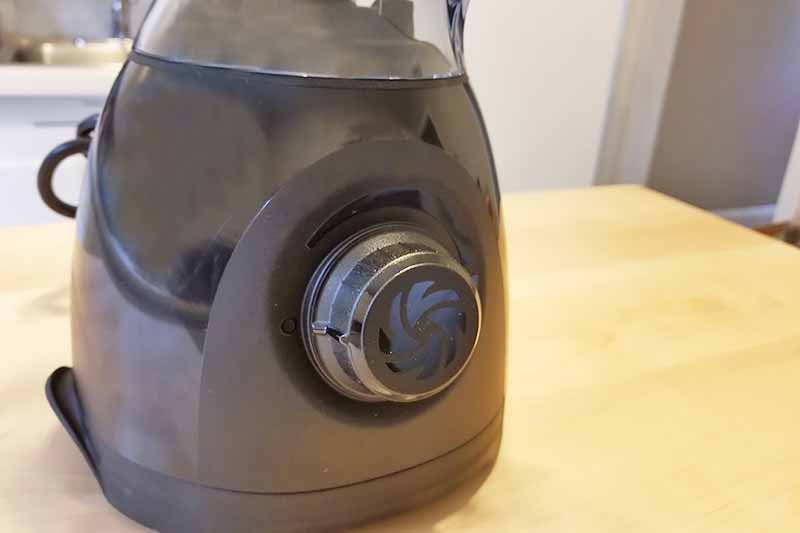
Simply turn up the variable speed dial to increase the speed, and turn it back down again to slow it, and then off when you’re finished blending.
Whereas getting the hang of the power switch plus on/off and pulse switch plus speed knob combination of the classic models can take some getting used to, the simple, streamlined control available with the ONE is completely intuitive. Although, for users formerly acquainted with the controls on larger models, switching to the ONE may prove to be a bit of an adjustment.
Rather than ramping up the speed gradually, or pulsing to grind ingredients before turning up the speed to puree, it’s recommended to “start the blender, then quickly ramp it to high for best results when using the ONE,” according to a statement found in the product description on the Vitamix website.
The basic blending instructions in the user manual also say “Blend It: Start the machine, quickly increase to its highest speed, and blend for 45 to 60 seconds.” A version of pulsing can be achieved manually, by turning the knob up and down to alternate between faster and slower speeds, or by using a “pulse-and-tamp” method of quickly turning the blade on and off, and alternating with the tamper.
Confusingly, a note of caution in the user manual reads, “Always start on low speed then slowly increase to high” and quickly ramping up the speed is not recommended, according to the “Important Instructions for Safe Use” section of the user manual, though it’s touted elsewhere as a recommended option for best results. Something is amiss here… Perhaps this will be clarified in a future version of the user manual and/or website copy.
Another feature that this model lacks, and one that I very much appreciate with my full-size model, is an additional on/off switch on the back of the base unit.
Why is that? Because, on the off chance that I inadvertently flipped a few switches when cleaning the kitchen and I go to plug in my already-full blender with canister in place and – oops – the lid is not on quite yet, I don’t have to risk splattering smoothie goo all over my kitchen. But maybe that’s just me.
With just one control knob, the chances of this are less likely, but not impossible. Be sure that the lid is always securely in place before you plug it in. The user manual warns, “If you unplug the unit and plug it back in when the Variable Speed Dial is not pointed at “O,” the motor will start at the speed indicated on the Variable Speed Dial.”
The knob does have what I’ll call a bit of a pause between on and actually starting the blender blades a-whirring, which you feel as sort of a notch that the knob settles into as you begin to turn it from the off position.
The gray plastic mini tamper is similar in style to what you’ll find with their other models, with a slightly different shape than what I was previously familiar with as a Vitamix 7500 user.
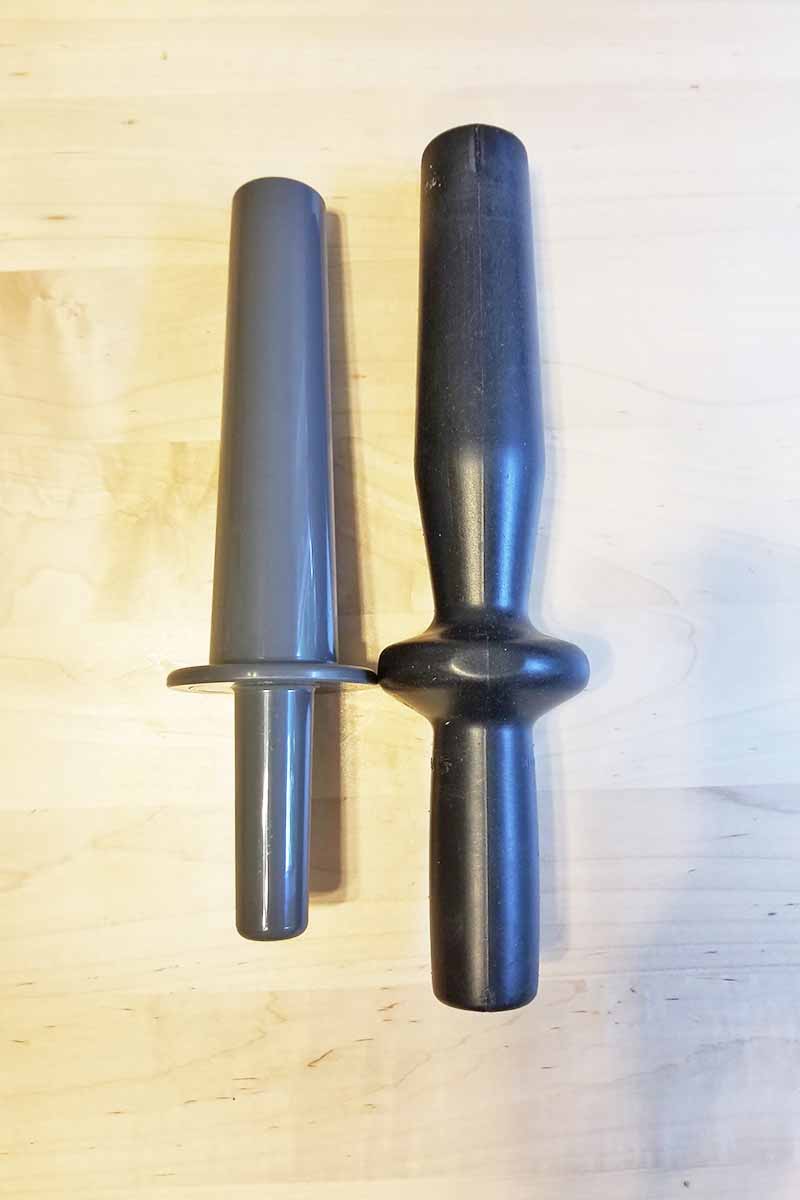
It’s lighter and narrower, with more of a tapered blunt-ended cone shape than what you’ll see with their full-size products, which is generally more club-shaped and wider.
The tamper handle itself is also very narrow, and the splash disk – a ring of plastic under the handle that holds it in position when you insert it into the lid high enough so it doesn’t hit the blades – is thinner as well.
Though it’s made of sturdy Tritan plastic rather than glass, the blender pitcher very much reminds me of the classic models I remember from my childhood (and my mother’s childhood!).
The pitcher handle has a nice feel in the hand, and it’s connected at both top and bottom to the canister. The pouring spout is on the wide side for quick pouring, and I find this makes it a bit easier to clean than what you’ll see with some other brands of a similar style.
It has clear markings on one side in cups, with 4 cups being the max fill line, and 250, 500, 750, and 945 milliliters are marked on the reverse side.
The plastic container is also ribbed on the outside with a decorative pattern of five vertical lines on each of the four sides, in what I’d describe as a sort of seashell design or chevron at the top.
I’m not sure whether these are meant to add a little extra grip to the canister or not, since presumably, you should be lifting it by the handle. They are on the exterior of the canister, and the central rib on each side is also duplicated on the inside – so you will need to be sure to clean well around these, as the interior is not completely smooth.
The lid is a definite improvement on what I remember from my glass blender of old, in this case a miniature version of what you’ll see with their classic models. Black plastic makes a tight seal with two grips on either side that can be lifted for easy removal, and a clear cap in the lid can be twisted to lock it in, or for easy removal.
The hardened stainless steel blending blade is identical in style to the traditional version used by Vitamix, laser cut and tapered to an angle away from the base, with four roughly triangular points. However, these are about half the size in the ONE as what you’ll see with other models (like my 7500, pictured here).

The box also includes a leaflet inviting new users to join the Vitamix Rewards program online and a short user manual, as well as information about accessing the user guide and recipes online.
Ready to start shopping? You can buy the ONE now direct from the manufacturer, or read customer reviews and check current prices on Amazon.

Vitamix One, available from Amazon
Not convinced yet? Keep reading!
What It Can (And Cannot) Do
A promise on the back of the packaging that reads “Try Lots of Blending Techniques” leads via an asterisk to a section of fine print in the bottom left corner. Oh good, we’re going on a scavenger hunt!
Close readers (or those who happen to have their bifocals with them) will note that “This container makes amazing smoothies, sauces, dips, and frozen treats, but is not intended to be used for hot soups, nut butters, or grinding grains.”
That’s right. The ONE is all about the basics.
Though the outside of the box doesn’t explicitly state this, it’s clear from the info available on the website, the booklet included in the box, the user manual, and so on that attempting these blending techniques will void the warranty.
A warning against the forbidden blending tasks is printed on a sticker on the blending pitcher as well, with a note to also familiarize yourself with the user manual to avoid the risk of injury and damage.
Info found on the website and in the user guide goes into a bit more detail about what exactly you cannot use this blender to do, and briefly touches on why. Doughs and hot ingredients (like hot drinks or soup straight from the stove, I’d imagine) are also forbidden, and this is because “Certain food applications can damage the container and void the warranty.”
From my point of view, this begs the question: how tough is too tough, and how hot is too hot?
Sure, I can tell the difference between a dough and a smoothie, but what about a nut butter versus a nut milk or smoothie? Is it possible to throw a piece of produce at this blender that it simply can’t take, though you were blending with the best of intentions?
Instinctively, I find being told what I cannot have on the packaging of a product that I am considering for purchase to be a bit of a disappointment. But I do understand where they’re coming from.
For a high-value brand positioned at the top of the market in terms of quality as well as cost, figuring out exactly how to present a less-juiced-up blender to potential consumers can be a bit of a balancing act.
The product listing, which describes the ONE as “designed to fit into your kitchen, your routine, and your lifestyle” hints at wholesome sentiments – family oriented, with a focus on home cooking and getting one’s daily dose of nutritious produce whenever they can, with the help of this appliance. That has always been the goal of Vitamix.
This description goes on to say users can “Enjoy simple operation, streamlined design, and the performance Vitamix is known for.” And this holds up!
Does the Vitamix ONE actually make mealtimes faster, tastier, and more fun, as is also advertised?
Though I’ll be the first to admit that the aftermath of a fun blender-made meal is outweighed to no small degree by forgetting to immediately rinse out your blender and clean it out ASAP in order to facilitate easy cleanup (ugh), the blending itself is quick, smooth, and easy.
The size of the blender pitcher may not be ideal for some recipes – it’s more akin to what might come to mind as an old-style Oster or other brand with push-buttons on the front of the base unit and a glass pitcher.
My grandmother had one of these in a mustardy shade of yellow that survived through my childhood, and as far as I can tell, many of these models from the ‘70s – if not the ‘50s and ‘60s – are still going strong today. It’s a retro style worth emulating.
Beyond what’s recommended on the box, according to info available on the website, you can also use this blender to make juice, nut milk, baby food, marinades, spreads, and cocktails, and use it for chopping ingredients for simple food prep as well.
Recommended recipes, some with video tutorials, are also available on the website and via a free Vitamix Rewards online account, but at the time of this writing, I found slim pickings among the recipes designed specifically for use with this model.
If you want to make a smoothie, a sauce, or a quick dip, baby food, or frozen banana “nicecream,” and you’re prepping food for just one to four people, this blender will serve you well. Just bring your own recipes. And never, ever attempt to make nut butter.
History and Naming
The release of the ONE coincides with Vitamix’s 100-year anniversary. A family business based in Ohio that has carried on through four generations to date, their interest in blenders has only grown stronger with each passing year. And at least to my eyes, this blender very much resembles some of their earliest models.
The name may seem a touch confusing. What does ONE mean?
A press release from the company confirms that this is a commemorative blender released in honor of the company’s centennial celebration. But I went in with this question when I first heard about this product, unaware initially of their impending anniversary, and I was eager to find out more.
After sifting through every piece of information available to me, I was drawn back to the tagline at the top of the product page on the website. It reads: Meet the ONE.
Subtle much? To me, at least, this firmly nudges the shopper toward a deep and highly significant concept: connecting with a life partner, a soul mate, a true love.
The cute 20-something in the ad is surrounded by cartoon hearts as they take a sip of freshly-prepared green smoothie. Love is clearly in the air.
Perhaps meant to appeal to the online dater who scrolls through thumbnails of potential mates on their phone during low moments at work and when they can’t sleep at night, in the same way they shop for clothes or groceries – or kitchen appliances – this tongue-in-cheek (at least to me) nod to something so serious and meaningful falls flat.
It’s cutesy, but there’s nothing else behind it, far as I can tell.
Presented in all caps, I really wanted the big, bold “O.N.E.” to stand for something. But we’ll have to stick with the marking of one hundred years of blending history as what’s being signified here, and leave it at that.
And hey, as far as brand names go, I honestly can’t remember the model number on my own beloved full-size Vitamix when pressed (which, thankfully, is not often, though I checked and double-checked it when writing this article). ONE, on the other hand, is probably a name that I’ll remember.
Not to be confused with The Quiet One, a commercial-grade blender from Vitamix that touts its lower-decibel operation via an easy-to-remove sound enclosure, this ONE actually resembles some of their earliest blender models from the ‘30s and ‘50s in design, combined with modern-day materials and components.
But that’s where the comparison ends. Though some early models were similar in shape, size, and style to this one, they were touted for being able to grind grains into meal and flour in two minutes or less, whereas this model simply cannot.
The Price
Vitamix has come to be associated with more than a few of the extra bells and whistles that other blenders simply can’t pull off, with a consistently higher price tag to match. Even refurbished models can cost a pretty penny in comparison to most blenders. But they are of higher quality in general, with a decent warranty to match, at least in most cases.
Paying a premium typically comes in exchange not for the prettiest blender on the countertop, but a true high-powered workhorse that can blend with the best of ‘em, creating everything from your basic smoothie to nut butters, flours, and even hot soup.
We’ve been over that. And this new model makes it clear, with a plain as day asterisk right on the packaging, that the ONE is something different.
Well, maybe it’s not quite clear or plain as day, unless you’re invested in reading all of the provided and publicly available copy closely. And oh, dear reader, I was.
I do it all for you. Just remember that.
But one of the most stunning features here is the lower price tag, paired with a quality blender that is slimmed down in both size and operation compared to other models. It’s an affordable product from a trusted brand.
Warranty
The Vitamix ONE comes with a 2-year warranty. Or, according to the copy on the outside of the box it does, and this is the length of the warranty stated on the website as well.
I must admit, I was somewhat baffled to find that the warranty info in the user manual included with this product in at least some boxes indicates that it comes with a “3-year full warranty.” This seems to be a misprint, and though the French version of the manual also includes the same info, the Spanish version in the same booklet describes the warranty as providing protection for up to two years.
This has been corrected in the version of the user manual that is available online.
Though the provided coverage is shorter than what you’ll find with beefier blenders from Vitamix, it’s decent.
Cleaning and Safety
The black plastic blender base may be wiped clean with a soft cloth, and it cannot be submerged in water.
The container, 2-piece lid, and tamper can be washed by hand with warm, soapy water, and the rubberized centering pad on top of the motor base can be removed as needed and cleaned as well. Just be sure it’s completely dry before putting it back in place.
Keep in mind that the smaller blending canister with this model also means the interior is a bit more difficult to clean than that of larger models. Anyone with particularly large hands might find it to be a bit of a tight squeeze to get in there around the blade with a soapy sponge if that’s not what they’re used to.
And of course, as with any blender, do be careful when cleaning the blades – they’re sharp!
Vitamix actually recommends washing this blender canister by filling the container halfway with warm water, adding a drop or two of dish soap, placing the lid on top, and blending on high for about a minute before rinsing.
(Please note again that I am paraphrasing and providing averages here – I found two different sets of cleaning instructions related to this model, and they offered slightly different suggested quantities of soap and blending times for cleaning).
Be sure to clean the blender fully and properly before the first use, and after that you can clean the blender by hand if you wish, or use this option to run the blender after filling it with soapy water rather than sticking your tender hands in there.
Whatever you do, be sure to clean it well promptly after use, or at least rinse it thoroughly and enjoy your dip or drink before returning to clean it. Nobody likes blending their food with gunked-up blades, and attentive cleaning practices will enable smooth(ie) sailing.
The blender canister can also be sanitized, using 1 1/2 teaspoons of liquid bleach instead of the dish soap, and letting the mixture stand in the canister for 90 more seconds after blending. Dump out the liquid, skip the final rinse after sanitizing, and allow the container to air dry.
I encourage anyone who uses this sanitizing method to be extremely careful. I do not use bleach in my own kitchen, but you do you.
No matter what you do, you shouldn’t remove the blade assembly for cleaning. This might come as a surprise to some of the old-school “standard” blender users of yore out there, who were used to removing the blades every time they used their appliance. But that’s simply not the case here.
Having said that, let’s talk just a bit more about safety!
The motor is “designed to protect itself from overheating” via what’s referred to as “thermal protection” in the user manual, and should be allowed to cool down for 20 to 45 minutes before attempting to use it again if it has overheated.
Tips regarding the motor in the user manual offer suggestions to prevent overloading it, which include processing only Vitamix recipes while learning, and not processing recipes at lower or higher speeds than what’s recommended. Processing for longer than is recommended should also be avoided.
There’s also a warning that you should never operate the ONE if the canister is empty, and it should not be used continuously for more than 3 minutes.
The tamper is intended to help push tougher ingredients towards the blades and keep the ingredients moving, and the one that’s provided is only made for use and meant to fit this particular blender model.
Fine print in the user manual also notes that the tamper should not be used if the container is more than two-thirds full. The potential is certainly there, in a smaller blending canister with a tamper, to have a real mess on your hands, so be sure to heed this warning!
The tamper also shouldn’t be used for more than 30 seconds at a time, though I’ll admit I am not entirely clear as to why.
What you’re really supposed to try to do when you’re using it is stir until the mixture “burps.” But blending can be a tricky business, so you’ll sometimes need to shut the blender off to move things around and scrape down the sides with a spatula, or add a bit of extra liquid to get everything going.
None of this occasional fiddling is unique to the ONE – this is true of all blenders of this style, and even a “perfectly proportioned” recipe might be a little less or a little more liquidy from one time that you make it to the next, since we’re dealing with natural whole food products here that can contain varying levels of moisture.
Or maybe you just measured wrong. It happens!
Pros and Cons
There are some potential caveats as well as plenty of pluses to the Vitamix ONE. We’ll begin with the negatives.
As for downsides, there are a few, though they are minor.
First, placement of the canister on the base is not 100% intuitive. Unlike other larger Vitamix blenders which have a square base, the base here is round, and you’re likely to find yourself dealing with a bit of a “square pegs, round hole” situation.
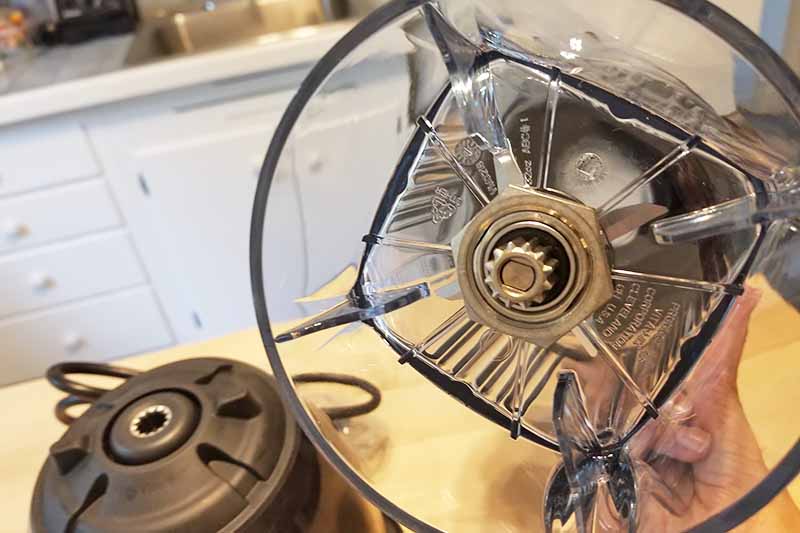
With a bit of turning if you don’t hit it just right the first time (as is sometimes true when you think you’ve found the one? Just kidding, I know I promised to drop that concept…), it’s easy enough to figure out how the plastic prongs on the bottom of the canister should be seated into the centering pad on top of the motor base.
Of course, I can’t guarantee that your roommate will have the patience after a few batches of frozen margaritas have been downed and the guests are in need of more (though, perhaps this can serve as a cue that it’s time to take a pause for a bit on the bevvies!).
Cord storage in the base would be nice, but it’s not a must. However, at the price point we’re talking about here, I would have liked to see that added feature.
I also miss the easy-grip handle of the large classic-style pitcher, but since the overall capacity of this model is significantly smaller, it’s not really necessary.
As for what exactly blending too slowly or too quickly might entail, I could only find four sample recipes provided on the website. I suppose you could experiment with those repeatedly until you get a feel for things, but as someone who is not new to cooking altogether, this option doesn’t appeal to me. Hopefully Vitamix will improve their tutorials and offer more recipe options in the future.
There was also a bit of an odor from the motor running after the first couple of uses, something I’ve found is typical of most blending appliances until you’ve broken them in a bit. It’s nothing to worry about, though perhaps just a touch unpleasant, particularly for those who are sensitive to smells. And of course, you should be sure to wash all of the washable parts well before the first use.
My kitchen cabinets are not standard (for modern times, at least) and this blender does not fit beneath them when the canister is in place on top of the base. But this may not be a problem in your kitchen, and it really does have a very narrow footprint.
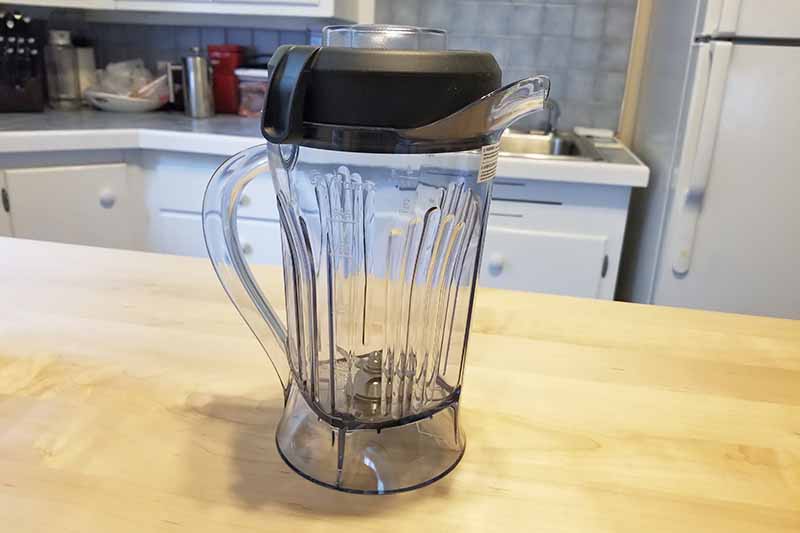
Off the base, I could store it on the countertop if I wanted to – the canister with the lid in place on top is 10 inches tall, and the base alone is 7 inches tall. But I generally prefer to store my Vitamix with the canister on top, to avoid getting dust or any spills on or in the motor base.
On the plus side, this is a basic blender with a few added touches – like an ergonomic lid and a tamper – that you won’t get with most blenders of this size and style.
The base is easy to move even with one hand, which is not the case for larger models (at least if you’re underpowered in the arm muscle department, or have weak wrists or elbows, like I do!).
Feet on the base grip the countertop nicely, so you don’t have to worry about it skidding across the countertop while it’s in use.
For those who are cooking for one or in small groups on vacation, and blending up a couple beverages at a time, a few smoothies, or a batch of salsa, this piece of kitchen gear is sure to hit the spot!
What about the lack of dough-making ability? Personally, though I’ll sometimes whip up a pie crust by prepping the dough in my food processor, this isn’t something that I turn to my Vitamix for, so I wouldn’t miss that option with the ONE.
I also often use my immersion blender directly in the pot for processing already piping-hot ingredients, and I don’t typically rely on the soup-heating abilities of my full-size model. Others who’ve never had the option won’t miss it.
However, not being able to make nut butter is really the kicker for me.
Sure, I love the extra-smooth smoothies that my larger Vitamix 7500 can crank out, as well as frozen cocktails and quick purees. The ONE has those down pat too. But something that makes Vitamix blenders different in my mind is the ability to make the smoothest homemade nut butter like a champ.
Knowing this model just can’t cut it, I see no reason to swap it in for my old standby – even if it does fit a bit better in the tight spot between my sink and the overhead cabinets in my kitchen.
Nonetheless, I am confident that this device will make a great gift!
If you’re looking for something even smaller than this, to make nothing but small batches of chutney or salsa and a smoothie once in a while, check out the NutriBullet line of products and do a little comparison shopping.
If you don’t have nut butter on the brain, and you want to be able to make 32 ounces of soup, juice, baby food, or frozen margaritas at a time, particularly for those who are new entrants to the world of Vitamix, this just may be the blender for you, or for someone you love who is excited about healthy eating, with super smooth results.
As for whether or not it’s too loud, please remember, dear reader, that all blenders are loud, particularly if you’re chopping up chunks of ice. And if you’re wondering, “How smooth is smooth?” I’ll leave you with a quick tip:
As is the case with all blenders, here’s something all smoothie-making pros are no doubt very familiar with, and that others may be utterly unaware of when it comes to using these nifty countertop appliances. The order in which you load up your ingredients is key if you want them to blend together with ease.
What does this mean? Essentially, the hardest, heaviest items should be added in small pieces whenever possible, and placed furthest from the blade.
In this case, a pitcher with blades at the base, liquid ingredients should go in first, followed by dry ingredients (like powdered add-ins), leafy greens, then other fruits and vegetables, and finally, ice and other frozen ingredients like blueberries or chunks of pineapple.
The Perfect Pick for Up-and-Coming Vitamix Fans
Personally, when I first heard about this new appliance that was about to be added to the well-known brand’s line, I thought of my mom and my nephew.
Not Vitamix owners themselves (yet…), while Mom has temporarily hopped on the soft foods train to deal with some digestive issues, my young nephew has recently graduated from a milk-only diet to soft foods and is loving the whipped veggie treats that my brother prepares for him, eager to see whether blended green beans, cauliflower, or squash from the garden will bring a smile to his face.
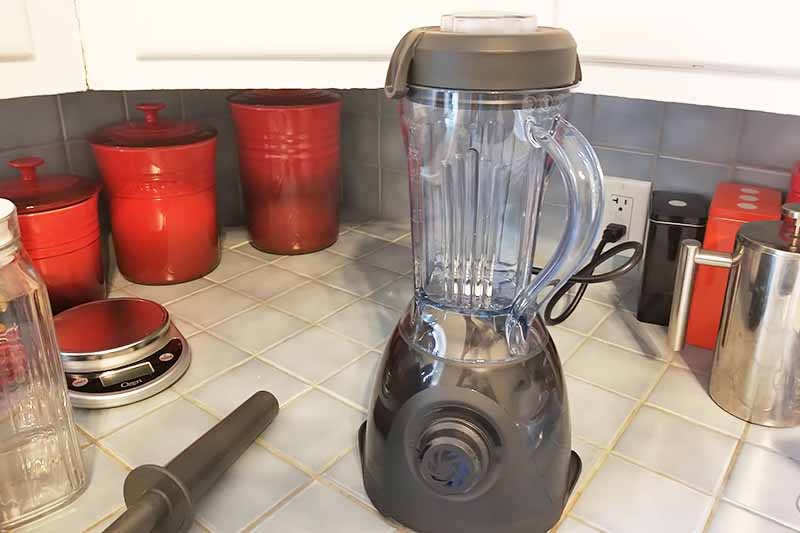
At the end of the day, here’s what this new blender from Vitamix is perfect for: gifting.
Whether your best friend is moving into a new apartment, your niece is graduating from college, your cousin’s getting married, dad’s celebrating a big birthday, or your beloved neighbor’s finally getting into the healthy morning smoothie game, anything from Vitamix is sure to be a hit that’s unwrapped with a smile. This is still a substantial gift in most contexts, in terms of the price tag, but it’s not astronomical.
Described as “slimmed down” in comparison to the classic Vitamix models to provide an excess of free counter space, the package copy touts the benefits of using the ONE to “blend tough, fibrous fruits and veggies into smoothies, dressings, sauces, purees, & frozen desserts.”
The efficiency-apartment kitchen owner, RV traveler, and weekend blended cocktail-making road warrior will love this piece of kitchen kit too.
If you are short on space, or lacking in the arm strength department, this may prove to be a worthwhile buy.
If you are eager to proudly display a Vitamix branded product on your countertop for all to see, on the other hand, don’t go for this one – because I hate to tell you, though those in the know may recognize that swirly logo of theirs, it’s the black and white “Vitamix” stamp and square shape that most prosumer blending aficionados know and recognize on sight, and this blender lacks those features.
I’m still not sure whether a blender of this size is the best fit for my own routine or lifestyle, but for you, well… maybe this could be the ONE. (There it is again!) Find it now from Vitamix.
Let me know what you think in the comments, if you have questions about this product, or if you already own one and you have your own notes to share.
And if you’re interested in other types of blenders to comparison shop, start with these reviews from Foodal next:
- Breville Super Q Blender: A Practical Blend of Beauty and Brawn
- The Vitamix 750 Is a Beautiful Work Horse for the Home Kitchen
- A Look at the Vitamix S30 Personal Blender
Credited photos by Allison Sidhu © Ask the Experts, LLC. ALL RIGHTS RESERVED. See our TOS for more details. Product photos via Vitamix. Test product provided by the manufacturer.
About Allison Sidhu
Allison M. Sidhu is a culinary enthusiast from southeastern Pennsylvania who has returned to Philly after a seven-year sojourn to sunny LA. She loves exploring the local restaurant and bar scene with her best buds. She holds a BA in English literature from Swarthmore College and an MA in gastronomy from Boston University. When she’s not in the kitchen whipping up something tasty (or listening to the latest food podcasts while she does the dishes!) you’ll probably find Allison tapping away at her keyboard, chilling in the garden, curled up with a good book (or ready to dominate with controller in hand in front of the latest video game) on the couch, or devouring a dollar dog and crab fries at the Phillies game.

